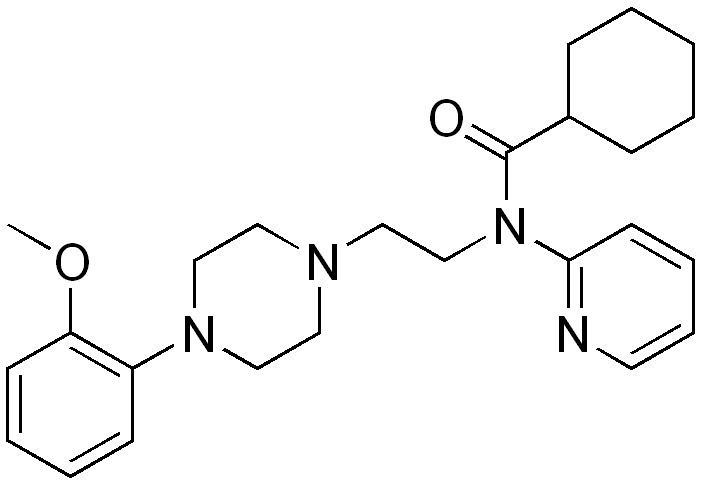CAS Number 146714-97-8 Formula C25H34N4O2 Molar mass 422.56 g/mol ChEMBL ID 31354 IUPHAR/BP 80 | IUPHAR/BPS 80 3D model (Jmol) Interactive image PubChem CID 5684 ChemSpider ID 5482 | |
 | ||
WAY-100,635 is a piperazine drug and research chemical widely used in scientific studies. It was originally believed to act as a selective 5-HT1A receptor antagonist, but subsequent research showed that it also acts as potent full agonist at the D4 receptor. It is sometimes referred to as a silent antagonist at the former receptor. It is closely related to WAY-100,135.
Contents
In light of its only recently discovered dopaminergic activity, conclusions drawn from studies that employed WAY-100635 as a selective 5-HT1A antagonist may need to be re-evaluated.
Human PET studies
In human PET studies WAY-100,635 shows high binding in the cerebral cortex, hippocampus, raphe nucleus and amygdaloid nucleus, while lower in thalamus and basal ganglia. One study described a single case with relatively high binding in the cerebellum.
In relating its binding to subject variables one Swedish study found WAY-100,635 binding in raphe brain region correlating with self-transcendence and spiritual acceptance personality traits. WAY-100,635 binding has also been assessed in connection with clinical depression, where there has been disagreement about the presence and direction of the 5-HT1A receptor binding. In healthy subjects WAY-100,635 binding has been found to decline with age, — though not all studies have found this relationship.
Radioligands
Labeled with the radioisotope carbon-11 it is used as a radioligand in positron emission tomography (PET) studies to determine neuroreceptor binding in the brain. WAY-100,635 may be labeled in different ways with carbon-11: As [carbonyl-11C]WAY-100,635 or [O-methyl-11C]WAY-100,635, with [carbonyl-11C]WAY-100635 regarded as "far superior". Labeled with tritium WAY-100,635 may also be used in autoradiography. WAY-100,635 has higher 5-HT1A affinity than 8-OH-DPAT.
Other actions
WAY-100,635 has also been found to increase the analgesic effects of opioid drugs in a dose-dependent manner, in contrast to 5-HT1A agonists such as 8-OH-DPAT which were found to reduce opioid analgesia. However, since 5-HT1A agonists were also found to reduce opioid-induced respiratory depression and WAY-100,635 was found to block this effect, it is likely that 5-HT1A antagonists might worsen this side effect of opioids. Paradoxically, chronic administration of the very high efficacy 5-HT1A agonist befiradol results in potent analgesia following an initial period of hyperalgesia, an effect most likely linked to desensitisation and/or downregulation of 5-HT1A receptors (i.e. analogous to a 5-HT1A antagonist-like effect).
